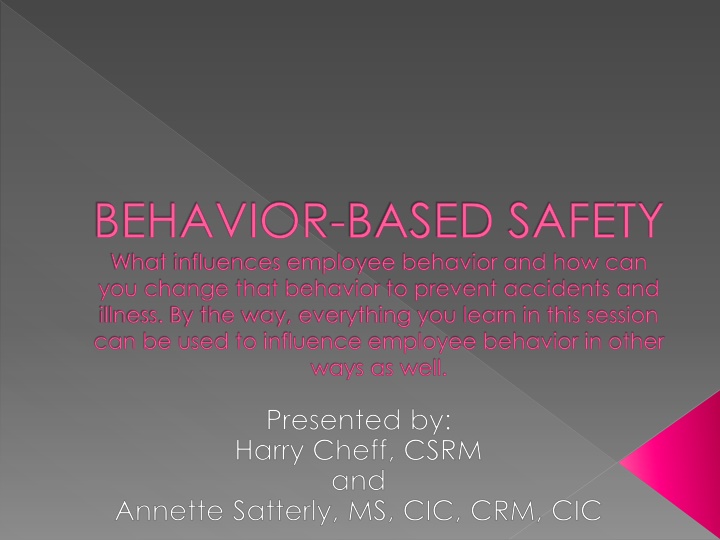Influencing Employee Behavior for Safety and Performance Improvement
Understand the factors influencing employee behavior related to safety, learn how to change behaviors to prevent accidents and illnesses, and improve overall performance. Explore concepts like ABC analysis, consequences, positive reinforcement, and the ABC model to effectively shape and reinforce desired behaviors in the workplace.
Download Presentation

Please find below an Image/Link to download the presentation.
The content on the website is provided AS IS for your information and personal use only. It may not be sold, licensed, or shared on other websites without obtaining consent from the author.If you encounter any issues during the download, it is possible that the publisher has removed the file from their server.
You are allowed to download the files provided on this website for personal or commercial use, subject to the condition that they are used lawfully. All files are the property of their respective owners.
The content on the website is provided AS IS for your information and personal use only. It may not be sold, licensed, or shared on other websites without obtaining consent from the author.
E N D
Presentation Transcript
BEHAVIOR-BASED SAFETY What influences employee behavior and how can you change that behavior to prevent accidents and illness. By the way, everything you learn in this session can be used to influence employee behavior in other ways as well. Presented by: Harry Cheff, CSRM and Annette Satterly, MS, CIC, CRM, CIC
Session Objectives Understand how safety behavior is shaped Analyze employee behavior Pinpoint, observe, and measure specific behaviors Provide positive feedback Use positive reinforcement successfully to improve safety performance
What You Need to Know ABC Analysis Antecedents, Behavior, Consequences Types of consequences How to strengthen consequences Pinpointing, observation and measurement Feedback and goal setting Types of positive reinforcement Reinforcement mistakes
Why Employees Engage in At-Risk Behaviors Jobs get done faster Perception that risk is low Nothing is going to happen to me attitude At-risk behavior is reinforced Lack of awareness that behavior is risky
ABC Model Antecedent Behavior Consequences
Antecedents Prompt people to act Precede the behavior Communicate information Work best with consequences Work only in short term if no consequences
Consequences Stronger than antecedents Consequences has negative connotation Positive consequences change behavior Consequences strengthen or weaken behavior Four categories of consequences Punishment Extinction Negative Reinforcement Positive Reinforcement
Punishment Getting what you don t want Criticism, injury, written warning Stops unwanted behavior
Extinction Is not getting what you want Is no recognition, no acknowledgement Often decreases wanted or safe behavior Can cause safe performers to slip
Negative Reinforcement Not getting what you don t want Avoiding criticism, unpleasant tasks, or accidents Performing desired behavior to avoid punishment Performing desired behavior only when boss is watching
Positive Reinforcement Getting what you want Acknowledgement, recognition, better work assignments Maintains or increases desired behavior Gives discretionary effort (more than asked) Behavior occurs more frequently
Examine the Behavior Results of the consequences How employee receives it Behavior increasing Behavior decreasing
Strength of Consequences Type positive or negative When immediate or future Probability certain or uncertain
Powerful Consequences Most powerful both immediate and certain Moderately powerful either immediate or certain Least powerful both future and uncertain
ABC Analysis Describe the behavior List all antecedents and consequences and describe strength of consequence Determine which consequences are motivating behavior Solution to problem behavior make weak consequences strong
Behavioral Safety Basic Do you understand the information presented in the previous slides?
Pinpointing Behavior Measurable Observable Reliable Controllable
Behavior Observation Observation checklist Spot check behaviors If safe behavior, mark safe In unsafe behavior, mark unsafe Turn card in Observations Feedback Safe Unsafe Positive Corrective Comments Pinpoint 1 xxx xx xxx x Pinpoint 2 x xxx x xxx Pinpoint 3 xxx x xxx x
Measurement Records observations and analyzes Uses objective measurement Measures safety process, not just results Gives feedback to employees and capture small improvements Is specific about performance and becomes positive reinforcement
Positive Verbal Feedback Be specific Be sincere Deliver immediately Be personal Don t use but or however
Corrective Verbal Feedback Don t ignore unsafe behavior Acknowledge small improvements Be objective Be specific Use a questioning approach Use a 4:1 ration
Graphic Feedback Past performance or baseline Current goals Presented and discussed frequently
Goal Setting Short-term and achievable Employee input More opportunities for positive reinforcement
Types of Positive Reinforcement Social reinforcement Written Verbal Physical Smile Humor Time or attention Just say Thank you
Types of Positive Reinforcement Tangible reinforcement Food Gifts Certificates Privileges Money
Using Tangibles Anchor the memory Be spontaneous Discuss behavior Different tangibles Avoid high-value tangibles Do not overuse tangibles
Reinforcement Do you understand the information presented in the previous slides?
Reinforcement Mistakes Too much positive reinforcement Expecting behavior to change too soon Reinforcement before behavior Giving unearned positive reinforcement
Key Points to Remember Learn how to use consequences effectively Analyze safety behavior with the ABC model Pinpoint behaviors and make observations Study collected data to measure results objectively Give positive feedback for safe performance and corrective feedback for unsafe behavior























